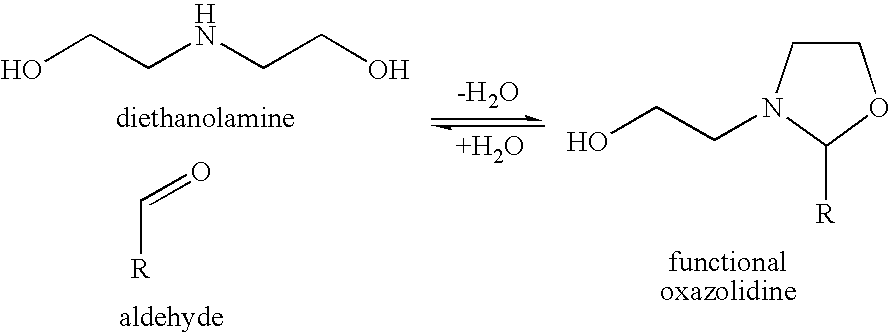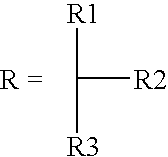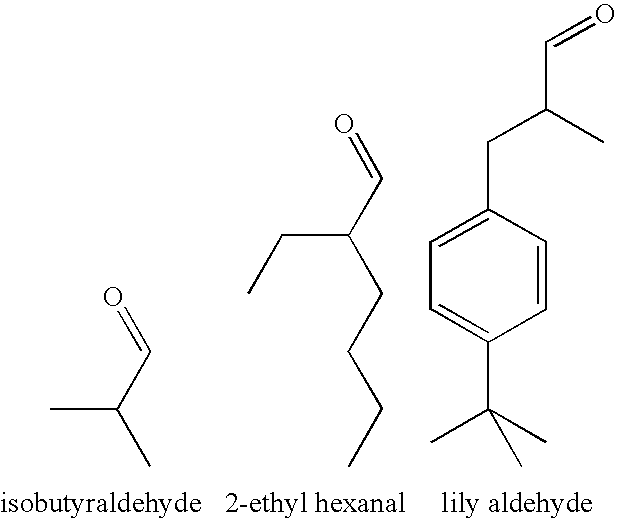Reactive hot melt adhesive
a hot melt adhesive and reactive technology, applied in the direction of adhesives, cellulose adhesives, other rubber adhesives, etc., can solve the problems of volatile free mdi monomer, unstable acid, decomposition, etc., and achieve low volatile monomer content and good mechanical properties
- Summary
- Abstract
- Description
- Claims
- Application Information
AI Technical Summary
Benefits of technology
Problems solved by technology
Method used
Image
Examples
example 1
[0076]Adhesive formulation A was prepared as follows: Polyol and acrylic components in the amounts (wt %) shown in Table 1 were blended together at 120° C. and vacuum applied for one hour. MDI was added and allow to react with the hydroxyl groups at 120° C. for one hour (NCO in excess), under vacuum. The remaining NCO was reacted with the hydroxyl functional oxazolidine at 120° C. for one hour under vacuum. The IPDI trimer was added and mixed for 30 minutes at 120° C., and a further 30 minutes under vacuum.
TABLE 1Formulation AVoranol P200046.1Elvacite 201616.3Dynacoll 73805.44,4′-MDI11.1Oxazolidine 311.5Vestanat T1890 / 1009.6
[0077]Formulation A was compared to a reference material, PURFECT-9021, a commercially available MDI based moisture curing —NCO functional adhesive. Results are shown in Table 2. Formulation A exhibits good overall properties in comparison to the reference material and would be particularly well suited for use as a panel laminating adhesive.
TABLE 2GreenMeltStabil...
example 2
[0078]Adhesive formulation B having the components (wt %) shown in Table 3 was prepared as described in Example 1 except that the non reactive EVA was blended with the polyol mixture before reaction with isocyanate.
TABLE 3Formulation BVoranol P200036.43CAPA 64006.74Elvacite 290318.7EVA 19-15015.0MDI9.73Oxazolidine 15.24Vestanat T1890 / 1008.06Modaflow0.1
[0079]Formulation B was compared to a reference product formulation, PURFECT-9008, a commercially available moisture curable adhesive based on —NCO functional prepolymers. PC lap shear specimens were evaluated after 2 weeks and results are shown in Table 4. Formulation B produced cohesive failure with higher lap shear strength at high temperature and would be particularly well suited for use as an assembly adhesive for plastic components.
TABLE 4MeltLap shearLap shearviscositystrength (4)strength (5)(mPa · s)(MPa)(MPa)B331006.0 (CF)1.78 (CF)PURFECT-900880006.2 (AF)0.97 (AF)(4) Method 4: Polycarbonate lap shear strength was measured at r...
example 3
[0080]A reference formulation based on MDI was compared to formulations C, D, E and F. These formulations have the components shown in Table 5.
[0081]Formulations C, D, E and F were made by reacting the —NCO with different hydroxyl functional oxazolidines. The —NCO / OH ratio for the initial prepolymer was 1.5 / 1 and then all remaining functional groups were reacted with the hydroxyl functional oxazolidine. IPDI trimer was added as the polyfunctional isocyanate in formulations C, D and E whereas MDI based prepolymer VPLS 2397 was added as the polyfunctional isocyanate in formulation F. The physical properties of these formulations are shown in Table 6.
TABLE 5referenceCDEFVoranol P200059.853.052.251.147.1Elvacite 201621.218.718.418.116.7Dynacoll 73807.06.26.16.05.5MDI12.010.610.510.29.5Oxazolidine 14.5Oxazolidine 26.05.4Oxazolidine 38.0Vestanat T1890 / 1006.96.796.65Desmodur VPLS 239715.8
TABLE 6Thermal stabilityCure rateLap shearMelt viscosity(% increase per(mm perstrength (1)(mPa · s)hour...
PUM
| Property | Measurement | Unit |
|---|---|---|
| Fraction | aaaaa | aaaaa |
| Fraction | aaaaa | aaaaa |
| Fraction | aaaaa | aaaaa |
Abstract
Description
Claims
Application Information
 Login to View More
Login to View More - R&D
- Intellectual Property
- Life Sciences
- Materials
- Tech Scout
- Unparalleled Data Quality
- Higher Quality Content
- 60% Fewer Hallucinations
Browse by: Latest US Patents, China's latest patents, Technical Efficacy Thesaurus, Application Domain, Technology Topic, Popular Technical Reports.
© 2025 PatSnap. All rights reserved.Legal|Privacy policy|Modern Slavery Act Transparency Statement|Sitemap|About US| Contact US: help@patsnap.com



